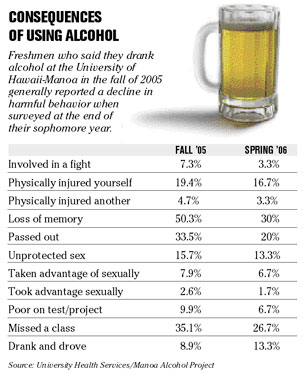UH boozers fall short in surveys
UH students drink less in U.S. college survey
STORY SUMMARY »
The University of Hawaii at Manoa might not be the party school many students think it is.
Two newly released surveys suggest UH-Manoa students do not drink as much as students on other campuses.
Dorm residents were skeptical.
"You come here early enough on a Saturday or Sunday morning and there's beer bottles on the ground," said freshman Taylor Griffith.
But Nancy Stockert, who conducted one of the surveys, said that while students believe the vast majority of their fellow students drink alcohol, her survey shows 43 percent never drink or had not had a drink in 30 days.
FULL STORY »
New surveys suggest students at the University of Hawaii at Manoa, including freshmen and sophomores living in the dorms, party with alcohol less and experience fewer consequences from drinking alcohol than students at other universities.
MANOA LOOKS DRIER THAN MOST
Some highlights of the new college drinking surveys:
Don’t drink or haven’t had alcohol in last 30 days:
UH-Manoa: 43 percent
National average: 33 percent
Binge drinking in last two weeks:
(defined as five or more drinks in one sitting)
UH-Manoa: 29 percent
National average: 38 percent
Source: University Health Services/Manoa Alcohol Project and National College Health Assessment survey
|
The surveys for the Manoa Alcohol Project and the National College Health Assessment also suggest that efforts to reduce student drinking are working but that more needs to be done to encourage students not to drink and drive.
"Students in general drink less than what people think," said Nancy Stockert, who conducted the Manoa Alcohol Project survey.
A national survey that included all undergraduate students found that 28.6 percent of all UH-Manoa undergraduates engaged in binge drinking, defined as five or more alcoholic drinks in one sitting, in the previous two weeks. That is below the national average of 38 percent.
But the survey also showed only 40 percent of Manoa students who drink "always" use a designated driver, compared with 59 percent of the national average.
The dorm survey for the Manoa Alcohol Project found 29.1 percent of freshmen in fall 2005 engaged in binge drinking, but by the end of their sophomore year, that number had dropped to 16.3 percent.
Drinking too much led to harmful consequences for some -- 50 percent of freshman drinkers in 2005 reported losing memory; 35 percent reported missing class; 33.5 percent passed out; and 15.7 percent said it led to unprotected sex.

But those numbers generally declined when the students became sophomores in the dorms.
Stockert said the dorm decline is in line with national studies that show students drink less as they progress through college. But it is still "statistically significant" because sophomores in the dorms reported much lower binge drinking (16 percent) when compared with the entire UH-Manoa undergraduate population (29 percent).
That suggests that alcohol education efforts in the dorms and the no-alcohol policy might be reducing binge drinking and the harmful effects of drinking, Stockert said.
Not all students living in the dorms agree.
"I know people who have had the ambulance called for them" for alcohol poisoning, said dorm resident Elliot Van Wie, a junior.
Van Wie said that if UH students drink less, it is because they smoke marijuana more.
Stockert said the surveys show it is a misconception that most students drink to excess. According to the surveys, UH-Manoa students believe only 2 percent of their classmates do not drink, but the percentage is actually much higher.
"We notice the person falling down drunk or making a fool of themselves, and we don't notice the 40 or so other people around them who only had one drink," Stockert said.
The surveys will be used to refine educational efforts to let students know that it is normal and socially acceptable not to binge-drink -- and to reduce the harmful effects of drinking, Stockert said.
The Manoa Alcohol Project surveyed freshmen who lived in the dorms in the fall and spring of 2005 and 2006, and followed up with a survey of dorming sophomores in spring 2007.
The National College Health Assessment surveyed a sample of 479 UH-Manoa undergraduates in the spring of 2007.
The most recent Manoa Alcohol Project surveys were funded with a $240,000, four-year grant from the Anheuser-Busch Foundation.

